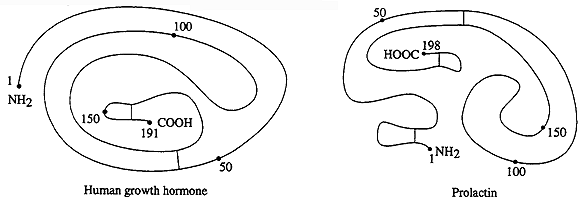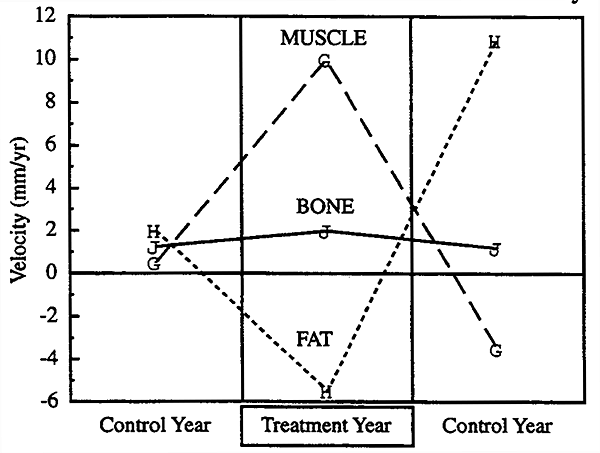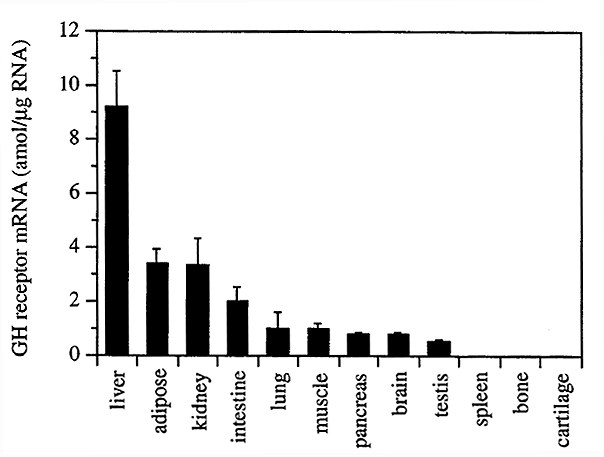
Neurobiochemistry II: Growth Hormone and Prolactin
Growth Hormone (GH): growth hormone originally harvested from the pituitaries of cadavers is now produced via genetic engineering. GH triples the growth rate of GH deficient babies in the first year of life.
Chemistry of Growth Hormone: 191 A.A.'s, accounting for ~5% of the weight of the pituitary
Comparison of the General Peptide Structure of Human Growth Hormone (hGR) and Prolactin (PRL) shows a 40% sequence Homology

Regulation of Secretion and Synthesis of GH:
Influenced by a variety of stimuli, i.e. sleep, exercise, acute stress.
Episodic and Pulsatile (regular release).
Plasma GH levels may change as much as 10-fold w/in minutes.
One of the largest increases occur shortly after the onset of sleep.
The stimulator of GH secretion is Growth Hormone Releasing Hormone (GHRH), which itself increases slow wave sleep and feeding behavior.
Insulin Like Growth Factor-I (IGF-I):
GH acts on bone by inducing the formation of a direct acting intermediate growth factor in the liver and kidney known as IGF-1.
IGF-I is a 70 A.A peptide with no sequence homology to GH.
The Actions of GH and IGF-I on Bone Growth, Muscle Growth and Fat Dissipation:

Receptors and Mechanism of Action:
The hGH receptor has been cloned.
It is a 10 kD protein with a single membrane spanning domain.
It shares sequence homology with the prolactin receptor and belongs to a "superfamily" of receptors whose ligands act on a variety of similar hematopoietic cell types.
The Hematopoietin Receptor Superfamily:
Hemopoiesis is the process of production of blood cells and platelets continuing throughout life to replace aging cells and bone marrow.
Growth Hormone Receptor:
A: Receptor dimerization is required for signal transduction.
B: GH has two binding sites for its receptor and causes two GH receptor monomers to form a dimer in the plasma membrane.
C: The dimerized GH receptor recruits a cytoplasmic tyrosine kinase, JAK-2, which phosphorylates the GH receptor.
D: Following phosphorylation of the receptor, Signal Transducers and Activators of Transcription (STAT) are phosphorylated and translocated to the nucleus where they produce the Bioeffects.
Bioeffects: increased IGF-I in liver, fat dissipation and A.A. uptake in muscle.
Tissue Specific Distribution of GH Receptor:

IGF-I is not structurally related to GH but has a similar amino acid sequence to insulin.
The IGF-I receptor is a tyrosine kinase receptor and is in the same subfamily with the insulin receptor.
There is 84% homology in the tyrosine kinase domain between the human insulin and IGF-I receptors.
The two receptors mediate similar biological responses, i.e. glucose modulation, A.A. transport and glycogen synthesis.
If the two receptors are biologically equivalent in vitro, why are the physiologic functions of insulin and IGF-I so different in vivo????
Answer: cell type distribution
Insulin Receptors: liver, muscle and adipose tissue
IGF-I Receptors: bone
Thus, different cells and tissues will selectively respond to low concentrations of either insulin or the IGF-1 hormones on the basis of which receptor is displayed.
The biological consequences of such responses will depend upon the specific functions of the cell types stimulated.
Prolactin (PRL):
Is a 198 amino acid protein, with a 40% sequence homology to GH.
This homology suggests that these hormones arose from a common ancestral gene.
The gene most likely duplicated about 400 million years ago and the duplications diverged approximately 50 million years ago to yield the two modern hormones.
PRL is present in pituitary at 1/100 the concentration of GH.
Regulation of Secretion of PRL:
The pituitary cells contain dopamine receptors, and dopamine decreases PRL release and inhibits PRL gene transcription (probably mediated by decreasing cAMP levels).
Estrogens stimulate PRL release, and stimulate PRL gene transcription.
PRL levels rise during late pregnancy and lactation.
Mechanism of Action of PRL:
PRL function is primarily confined to breast tissue, where PRL receptors are present in high concentrations.
The PRL receptor is similar to the GH receptor and operates in an identical manner.
Physiologic and Biochemical Action:
Reproduction:
PRL causes milk production and secretion
i) Mammotrophic actions: After stimulation by insulin (cell division) and cortisol (cell differentiation), PRL (stimulated by estrogen) causes final development of the breast for milk production
ii) Lactotrophic actions: PRL induces the production of a milk protein, casein, and enhanced milk secretion.
© Dr. Noel Sturm 2015